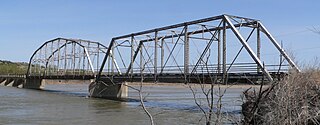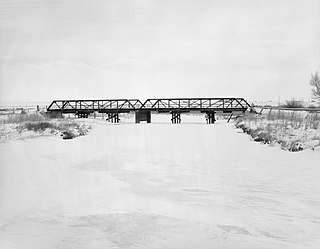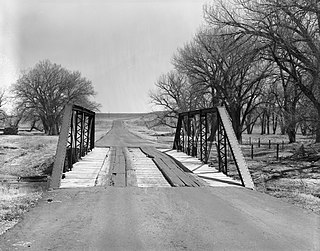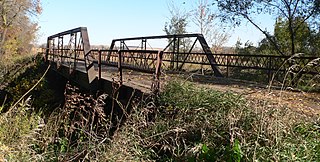The Nebraska Department of Transportation (NDOT) is the state government agency charged with building and maintaining the state highways in the U.S. state of Nebraska, as well as the state's airports. The main headquarters of the agency is located in Lincoln, the capital city. There are currently eight NDOT district offices located across the state.

The Western Bridge and Construction Company, located in Omaha, Nebraska, was one of the foremost bridge engineering and manufacturing companies in the Midwestern United States. Several of their bridges are now listed on the National Register of Historic Places. Their headquarters were located in the Bee Building in Downtown Omaha.

The Lisco State Aid Bridge is located on a county road over the North Platte River south of Lisco, Nebraska. Completed in 1928, the bridge today "is distinguished as an important crossing of the Platte River and one of the last two intact multiple-span state aid truss bridges" in Nebraska.

Witherup Bridge is a historic Pratt pony truss bridge located in Clinton Township, Venango County, Pennsylvania. It was built by the Canton Bridge Company in 1906. It measures 86-foot-long (26 m) and crosses the Scrubgrass Creek.

The Green Bay Road Bridge is a Pratt pony truss bridge across the Manitowoc River in Manitowoc Rapids. The 150-foot (46 m) bridge was built in 1887 by the Wisconsin Bridge and Iron Company and was the second river crossing built at its location. Originally a road bridge, the bridge is now used for a bicycle and walking trail; it is in good condition and is considered a historically significant example of a pony truss road bridge. The bridge was added to the National Register of Historic Places on August 3, 1998.

The ECR Kooi Bridge is a bridge in Sheridan County, Wyoming, located 2.7 miles (4.3 km) west of the community of Monarch. The bridge carries Sheridan County Road CN3-93 across the Tongue River. Contractor Jack Gregg built the bridge in 1913. The single-span pin-connected Pratt pony truss bridge is 81.6 feet (24.9 m) long with an 80-foot (24 m) span; it is the longest bridge of its type still in use in the Wyoming state and county highway system. The bridge's roadway was constructed with wooden stringers and decking; its guardrails are also wooden. The pin-connected Pratt pony truss was a common type of truss bridge in Wyoming, and the Kooi Bridge was one of the earlier bridges to use the design.

The Berry State Aid Bridge spans the Niobrara River in Cherry County, Nebraska near Valentine, Nebraska. It is a historic Pratt through truss bridge that is listed on the National Register of Historic Places.

Carns State Aid Bridge is a historic bridge that spans the Niobrara River about 10.8 miles northeast of Bassett, Nebraska. It is a Parker & Pratt through truss bridge built in 1912. It has also been known as Niobrara River Bridge and denoted as NEHBS No. RO00-72.

The ENP Bridge over Green River is a historic bridge located near Daniel, Wyoming, which carries Sublette County Road CN23-145 across the Green River. The Western Bridge and Construction Company built the bridge circa 1905. The 221-foot-11-inch (67.64 m) bridge has two spans, both Pratt trusses; the longer span is a Pratt through truss, while the shorter is a Pratt pony truss. The use of both through and pony trusses in the same bridge was uncommon in Wyoming, and the bridge is the only surviving example of a Pratt truss bridge in this style.

The DOE Bridge over Laramie River was a Pratt half-hip pony truss bridge located near Bosler, Wyoming, which carried Albany County Road CNA-740 across the Laramie River. The bridge was built in 1926 by contractor N. A. Swenson; it was originally part of the Lincoln Highway. In 1932, the bridge was replaced and moved to its current location. It was the last two-span Pratt half-hip truss bridge remaining in Wyoming.

The EWZ Bridge over East Channel of Laramie River is a Pratt pony truss bridge that was located near Wheatland, Wyoming, which carried Platte County Road CN8-204 over the East Channel of the Laramie River. The bridge was built from 1913 to 1914 by the Pueblo Bridge Company. The single-span bridge was 71 feet 2 inches (21.69 m) long. The bridge's five-panel Pratt pony truss design with steel pin connections was used fairly frequently in Wyoming highway bridges, and the bridge was one of the older examples of the style.

The Hale Creek Bridge is a historic bridge carrying County Road 271 over Hale Creek in Sevier County, Arkansas, near the village of Red Wing and about halfway between De Queen and Dierks. It consists of a single-span Pratt pony truss 30 feet (9.1 m) long, resting on concrete abutments. The bridge deck is 18 feet (5.5 m) wide and is surfaced in gravel. When the bridge was built in 1919, the roadway it carried was the major east–west route in the area. In 1926 this route was designated U.S. Route 70. It retained this designation until the current alignment of US 70 was built in 1952. The bridge is a fine local example of a Pratt truss bridge.

Scuppernong River Bridge, also known as the Main Street Bridge, Tyrrell County No. 4 Bridge, and Columbia Bridge, is a historic bridge located at Columbia, Tyrrell County, North Carolina. It was built in 1926, and is a 566-foot-long, two-lane bridge. Spanning the Scuppernong River, it consists of a steel Warren-type pony truss swing span measuring 123 feet long, and 22 concrete pile-supported timber approach spans. It is the only manually-operated pony truss swing-span bridge remaining in North Carolina.

The Boone River Bridge is a historic structure located north of Goldfield, Iowa, United States. It is a 6-panel, 128-foot (39 m) Warren Pony truss span over the Boone River. The construction began in 1910. The bridge was built in 1912 by the Iowa Bridge Company using steel fabricated at the Cambria steel mills in Johnstown, Pennsylvania. The Boone River Bridge is one of the few remaining multiple span pin-connected Pratt trusses in the state. It was listed on the National Register of Historic Places in 1998.
The Klondike Bridge is located southwest of Larchwood, Iowa, United States. The 260-foot (79 m) span carried traffic on 180th Street over the Big Sioux River. The bridge was first constructed at this point in 1901, but it proved inadequate to handle the traffic that followed, so in 1913 Lyon County hired the Western Bridge and Omaha Construction Company to create the Klondike. The Iowa Legislature passed the Brockway Act that required counties to use Iowa State Highway Commission (ISHC) standards for bridge construction rather than the counties acting on their own in 1913. The ISHC spent the next year standardizing plans. It is in this transition period that the Lyon County Board of Supervisors decided to replace an outdated 1901 span at this location. They contracted with the Western Bridge and Construction Company of Omaha, Nebraska to build this bridge. They used a Pratt through truss of their own design for the main span. It was flanked by two Warren pony trusses from the ISHC. In 1914, the structure was completed for $11,586.11. The historical nature of this bridge is derived from its construction in the transition period, and its use of standard and non-standard bridge designs. It was listed on the National Register of Historic Places in 1998. The span has subsequently been abandoned.

The Ponca Creek Bridge, also known as NEHBS No. BD00-224, is a historic Pratt truss bridge spanning Ponca Creek that is listed on the National Register of Historic Places.

The North Loup Bridge brings a county road over the North Loup River, about 1.5 miles northeast of the village of North Loup in Valley County, Nebraska. It was built in 1912-1913 by Empire Bridge Company of Omaha, Nebraska, at cost of $13,089, using steel parts fabricated by Cambria Steel Company and Lackawanna Steel Company. It is a Pratt through truss bridge and includes three 100 feet (30 m) through truss spans upon steel cylinder piers. There is also a 40 feet (12 m) pony truss approach span on the south side.

The Rattlesnake Creek Bridge brings a Cuming County, Nebraska county road over Rattlesnake Creek, 2.8 miles northwest of Bancroft. It was built in 1903 and was listed on the National Register of Historic Places in 1992.

The New Hampton Pony Pratt Truss Bridge is a historic pony Pratt truss bridge on Shoddy Mill Road in New Hampton of Lebanon Township, Hunterdon County, New Jersey. It crosses the Musconetcong River between Lebanon Township, Hunterdon County and Washington Township, Warren County. It was designed by Francis C. Lowthorp and built in 1868 by William Cowin of Lambertville, New Jersey. The bridge was added to the National Register of Historic Places on July 26, 1977 for its significance in engineering, industry and transportation. It is one of the few early examples of iron Pratt truss bridges remaining in the United States. It was later documented by the Historic American Engineering Record in 1991. It was added as a contributing property to the New Hampton Historic District on April 6, 1998.

The Glen Gardner Pony Pratt Truss Bridge is a historic pony Pratt truss bridge on School Street crossing the Spruce Run in Glen Gardner of Hunterdon County, New Jersey. It was designed by Francis C. Lowthorp and built in 1870 by William Cowin of Lambertville, New Jersey. The bridge was added to the National Register of Historic Places on September 22, 1977 for its significance in engineering, industry and transportation. It is one of the few early examples of iron Pratt truss bridges remaining in the United States. It was later documented by the Historic American Engineering Record in 1991.




















